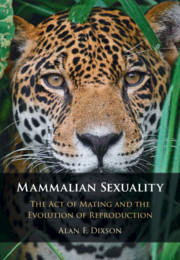Book contents
- Mammalian Sexuality
- Mammalian Sexuality
- Copyright page
- Dedication
- Contents
- Preface
- Acknowledgements
- Part I Carnival of the Animals
- Part II The Act of Mating
- Part III The Evolution of Reproduction
- 5 Phallic Structure and Function
- 6 The Testes and Spermatozoa
- 7 The Accessory Reproductive Glands and Ducts
- 8 Cooperation, Conflict and Cryptic Female Choice
- 9 The Evolution of Mating-induced and Spontaneous Ovulation
- Part IV Epilogue
- Book part
- References
- Index
5 - Phallic Structure and Function
from Part III - The Evolution of Reproduction
Published online by Cambridge University Press: 20 May 2021
- Mammalian Sexuality
- Mammalian Sexuality
- Copyright page
- Dedication
- Contents
- Preface
- Acknowledgements
- Part I Carnival of the Animals
- Part II The Act of Mating
- Part III The Evolution of Reproduction
- 5 Phallic Structure and Function
- 6 The Testes and Spermatozoa
- 7 The Accessory Reproductive Glands and Ducts
- 8 Cooperation, Conflict and Cryptic Female Choice
- 9 The Evolution of Mating-induced and Spontaneous Ovulation
- Part IV Epilogue
- Book part
- References
- Index
Summary
When Arthur Walton wrote these words, which appeared in the third edition of Marshall’s Physiology of Reproduction, he was unable to account for the evolutionary basis of phallic diversity in mammals, some examples of which are shown in Figure 5.1. Indeed, prior to the application of sexual selection theory to this problem (Eberhard, 1985, 1996; Parker, 1970), the presence of so much variability among male invertebrates, and among the vertebrates as a whole, had remained a mystery. The purpose of this chapter is to explore the various reasons for phallic morphological diversity, including the role that copulatory and post-copulatory sexual selection may have played in this context.
- Type
- Chapter
- Information
- Mammalian SexualityThe Act of Mating and the Evolution of Reproduction, pp. 111 - 154Publisher: Cambridge University PressPrint publication year: 2021

